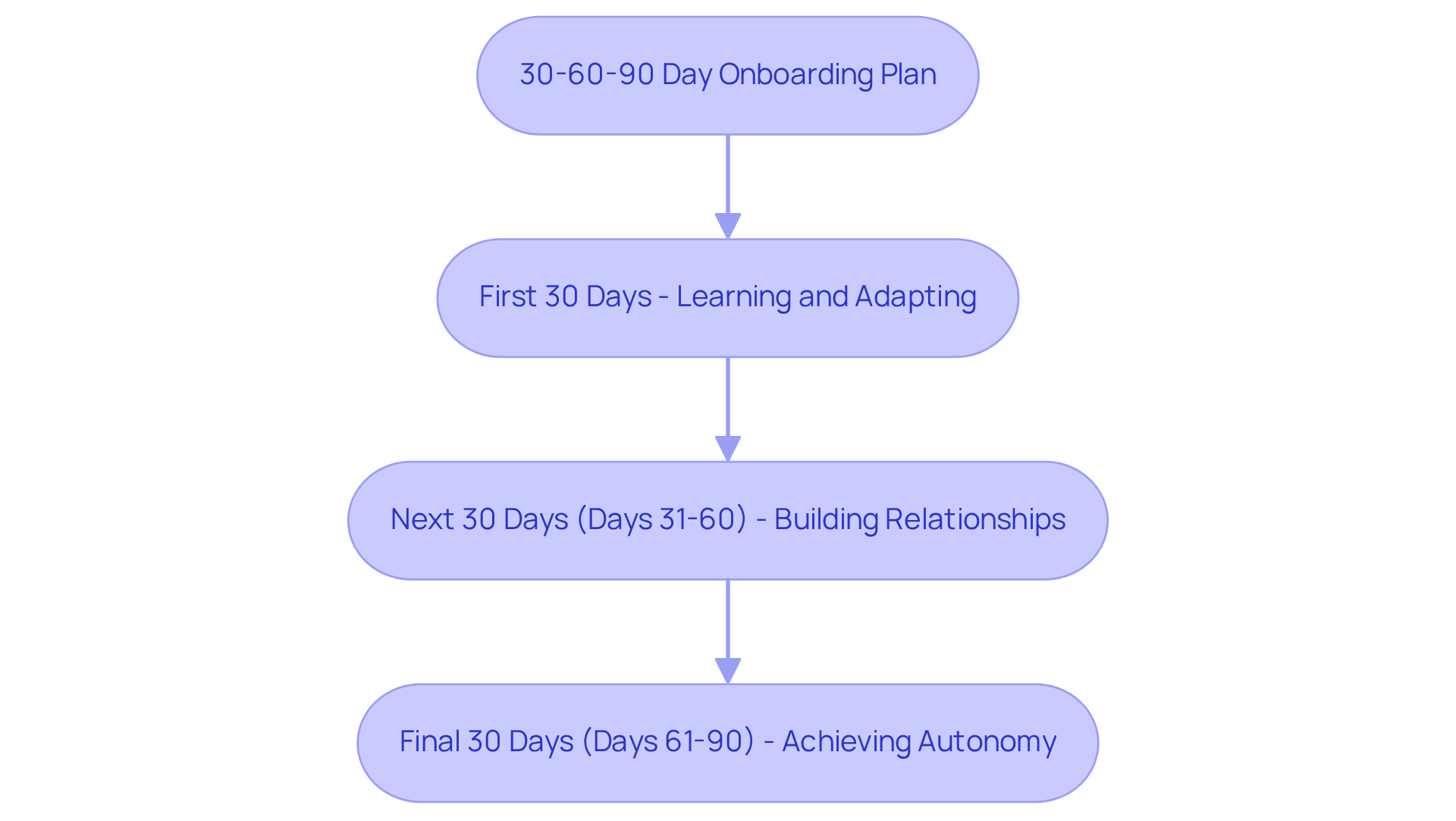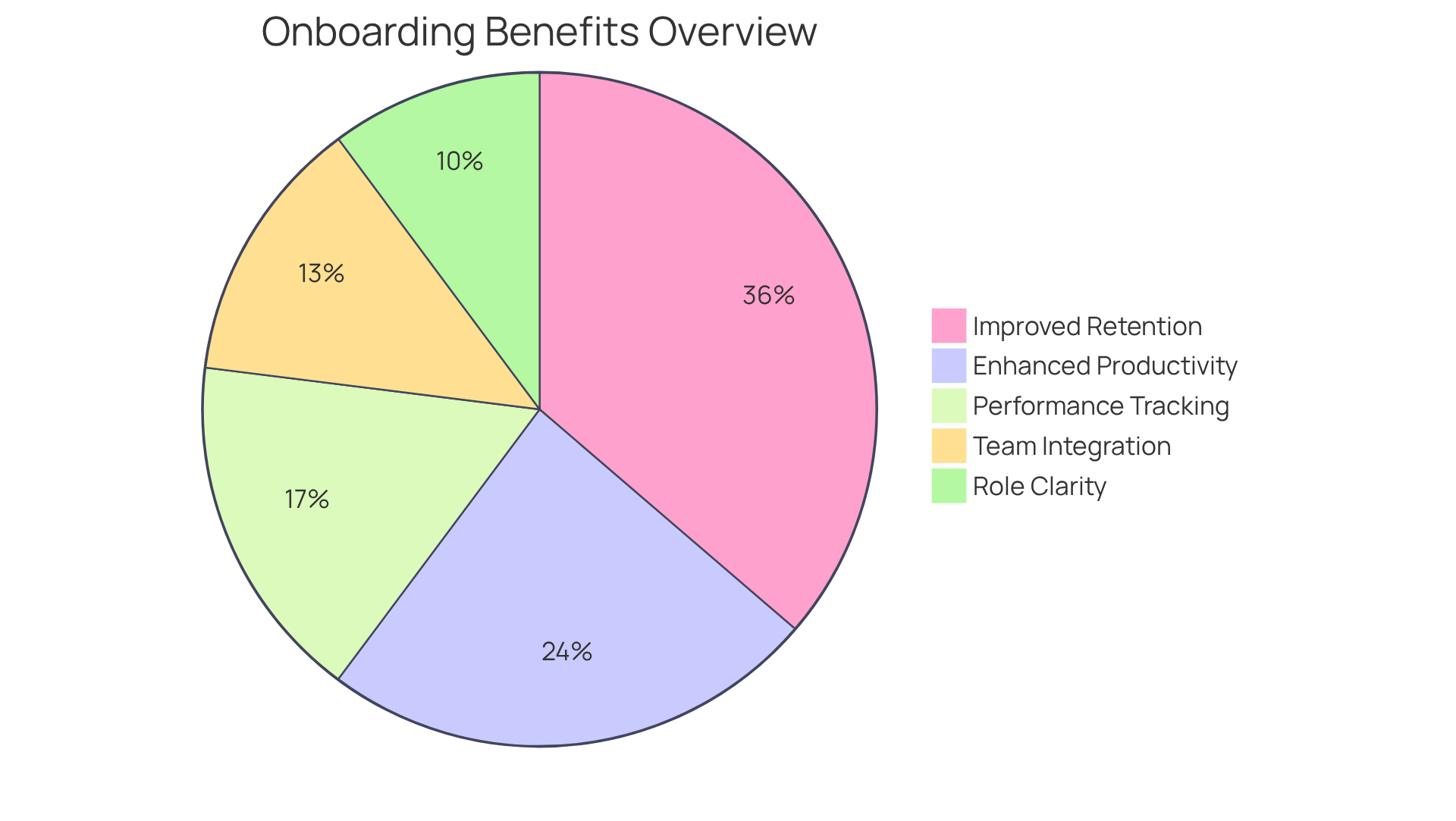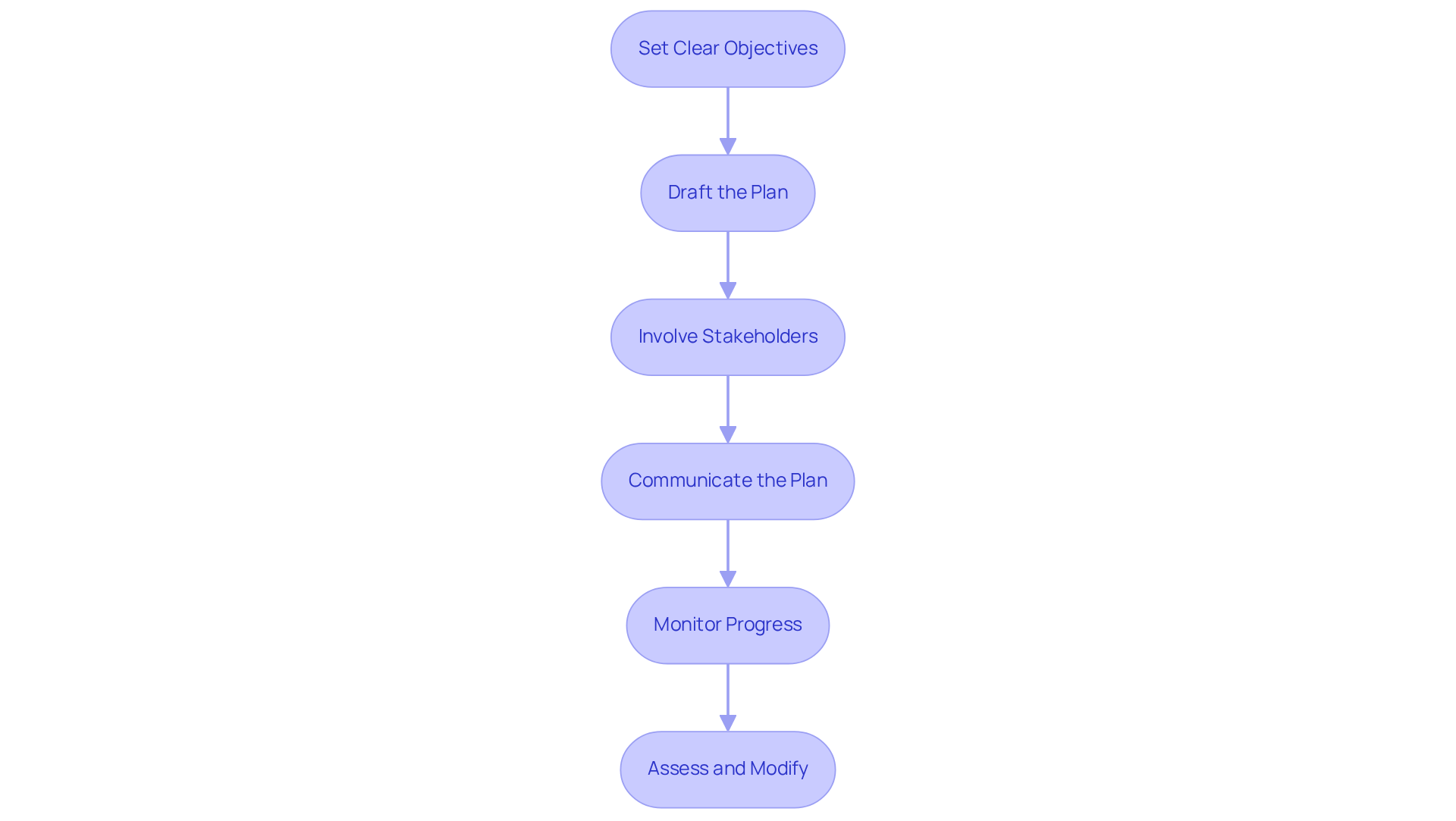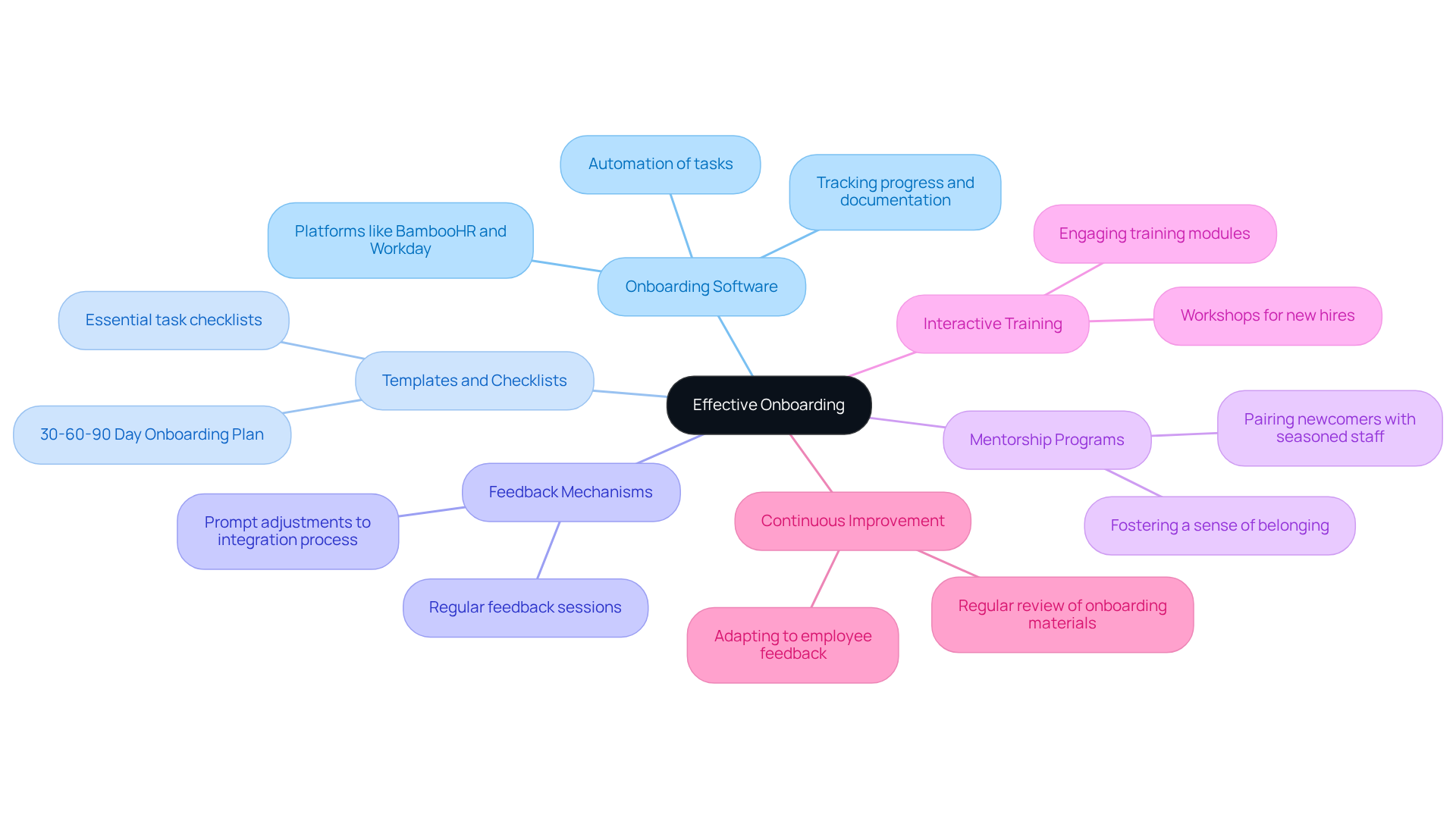
Streamlined Onboarding Processes
|
October 13, 2025
|
Create Your 30-60-90 Day Onboarding Plan Template for Success
Overview
You might be wondering how to create an effective 30-60-90 day onboarding plan template that really boosts new employee integration and success. Well, here’s the scoop: structured onboarding can make a world of difference! It’s all about clearly defining goals for each phase of the process, which not only helps in relationship-building but also encourages regular feedback. When you put all these pieces together, you end up with a more engaged and satisfied workforce. Who wouldn’t want that?
Key Highlights:
- The 30-60-90 day onboarding plan is divided into three phases: learning (first 30 days), relationship building (next 30 days), and achieving autonomy (final 30 days).
- Effective onboarding can increase employee retention by up to 82% and engagement by 69%.
- Structured orientation processes lead to higher productivity, with new hires reaching full competency within 90 days.
- Clear objectives reduce confusion about roles, improving job satisfaction and clarity.
- Regular performance tracking and feedback are crucial for aligning new hires with organisational goals.
- Involving stakeholders in the onboarding process enhances effectiveness and relevance.
- Utilising onboarding software, templates, mentorship programmes, and interactive training can significantly improve the onboarding experience.
- Continuous improvement of onboarding materials based on feedback ensures relevance and effectiveness.
Introduction
You might be wondering how important a well-structured onboarding process really is. It can actually be the cornerstone of employee success! Yet, many organizations overlook its significance. The 30-60-90 day onboarding plan template not only sets clear goals for new hires but also significantly boosts retention and productivity. But here’s the kicker: only a small percentage of employees feel fully integrated into their roles. So, how can companies effectively bridge this gap and ensure a seamless transition for newcomers? Let’s dive into this together!
Define the 30-60-90 Day Onboarding Plan
So, you might be curious about what a 30-60-90 day onboarding plan template is all about. Essentially, it’s a structured framework known as a 30-60-90 day onboarding plan template that lays out the goals and objectives for new employees during their first three months. This plan is broken down into three distinct phases:
-
First 30 Days: During this initial period, the main focus is on learning and getting comfortable with the company culture, policies, and procedures. It’s a great time for new hires to really dive into understanding their roles and responsibilities.
-
Next 30 Days (Days 31-60): As new team members settle in according to the 30-60-90 day onboarding plan template, the spotlight shifts to building relationships and contributing to team projects. This phase is all about applying what they’ve learned and gradually stepping up their responsibilities.
-
Final 30 Days (Days 61-90): In the context of the 30-60-90 day onboarding plan template, the goal is to achieve full autonomy in their roles, showcasing their skills, and blending seamlessly into the team. Typically, this phase includes performance evaluations and feedback sessions to ensure everyone is aligned with the company’s objectives.
Now, let’s talk about why organized introduction strategies are so crucial for keeping staff engaged and sticking around. Did you know that employees who go through a well-organized orientation process are 69% more likely to stay with the organization for three years? That’s pretty impressive! Plus, 76% of HR leaders agree that an efficient orientation is key to staff retention. And here’s a fun fact: individuals who have a stellar orientation experience are 2.6 times more likely to feel happy at work. However, it’s a bit concerning that only 12% of employees feel their organizations have done a great job integrating them. This points to a significant gap in current practices.
By investing in a solid orientation strategy, organizations can really boost new employee productivity and satisfaction, leading to a more dedicated workforce. So, what do you think? Isn’t it time to rethink how we onboard new team members?

Explore the Benefits of a 30-60-90 Day Plan
You might be wondering why a 30-60-90 day onboarding plan template is such a big deal. Well, let me tell you, it offers a ton of benefits!
First off, let’s talk about improved retention rates. Structured onboarding can actually boost employee retention by as much as 82%! That’s right—new hires feel more engaged and supported during those crucial initial months. Plus, did you know that 69% of staff are more likely to stick around for three years if they have a fantastic orientation experience? Pretty impressive, right?
Now, what about enhanced productivity? By setting clear goals and expectations, new team members can ramp up their productivity quickly, often hitting full competency within the first 90 days. And if you’re wondering about remote workers, effective integration can boost their productivity by 54% during those first six months.
You might also be curious about improved role clarity. When specific objectives are defined, it helps new employees understand their roles and responsibilities better, reducing confusion and ramping up job satisfaction. In fact, 23% of staff report feeling lost about their role expectations during initial training, which really underscores the need for clear goals.
And let’s not forget about enhanced team integration! This plan encourages relationship-building, which fosters a sense of belonging and collaboration among newcomers and existing staff. Companies that make team introductions part of remote orientation see a 29% increase in engagement. Now, who wouldn’t want that?
Lastly, there’s performance tracking. Regular check-ins and evaluations during the onboarding process provide timely feedback and necessary adjustments, ensuring new hires stay aligned with organizational goals. It’s crucial to note that 37.9% of employees leave a company within their first year, often due to poor orientation. This really highlights how important effective performance tracking is for retention.
So, are you ready to dive into creating a stellar 30-60-90 day onboarding plan template? It’s definitely worth the effort!

Create Your 30-60-90 Day Onboarding Plan: Step-by-Step Process
Are you creating an effective 30-60-90 day onboarding plan template? Let’s break it down together!
-
Set Clear Objectives: First things first, you’ll want to define some specific goals for your new employee in each phase. Using SMART criteria (you know, Specific, Measurable, Achievable, Relevant, Time-bound) helps keep things clear and focused, which boosts the chances of success. Fun fact: Employees who have a great orientation experience are 2.6 times more likely to feel satisfied at work.
-
Draft the Plan: Now, let’s get into the nitty-gritty. Create a handy 30-60-90 day onboarding plan template that outlines the objectives for each 30-day segment. Be sure to include specific tasks, training sessions, and milestones to guide the new employee through their orientation. And hey, using SowFlow's instant documentation solution makes it super easy to keep everything up to date and relevant!
-
Involve Stakeholders: You might be wondering, who else should be involved? Engaging team leaders and HR professionals can provide valuable insights on what new hires really need to thrive. This collaboration ensures that your integration plan is not just effective but also tailored to your organization’s unique needs. Remember, a manager's active involvement makes the process 3.5 times more effective!
-
Communicate the Plan: Before your new hire even steps through the door, share the orientation strategy with them. This proactive approach helps them prepare and sets clear expectations, making them feel right at home from day one. Plus, SowFlow's user manual creation features can help you whip up clear documentation for them to refer to, enhancing their integration experience.
-
Monitor Progress: Don’t forget to check in regularly! Schedule some time to discuss how the new employee is doing, tackle any challenges, and offer constructive feedback. This ongoing support is crucial since 89% of employees say they feel engaged when they receive effective orientation. SowFlow's documentation tools can help you keep tabs on progress and ensure all necessary info is easily accessible for everyone involved.
-
Assess and Modify: After the 90 days are up, take a moment to review the integration process. Gather feedback from both the new employee and their supervisor to pinpoint areas for improvement. This way, you can ensure that future integration strategies are even better! With SowFlow, updating and revising your orientation documentation is a breeze, allowing you to continuously enhance your strategies.
By following these steps and tapping into SowFlow's innovative documentation solutions, you can seriously boost your training processes. This leads to higher retention rates and happier employees. Did you know that businesses focusing on organized orientation experience a 50% greater retention of new hires? It really highlights the importance of a well-thought-out integration strategy!

Utilize Tools and Tips for Effective Onboarding
To enhance the effectiveness of your onboarding process, you might be wondering what tools and strategies could really make a difference. Let’s dive into some options that can help you out!
-
Onboarding Software: Have you considered platforms like BambooHR or Workday? They can automate onboarding tasks, track progress, and manage documentation efficiently. Studies show that organizations with structured orientation procedures see a 50% boost in new employee productivity. That’s a big deal, right?
-
Templates and checklists: How about creating a 30-60-90 day onboarding plan template along with checklists for new employees? This way, you can ensure that essential tasks and training are completed, making the transition into their roles a lot smoother.
-
Feedback Mechanisms: Regular feedback sessions are a great idea to evaluate the new employee's experience. This allows for prompt tweaks to the integration process, improving overall satisfaction and efficiency. Who wouldn’t appreciate that?
-
Mentorship Programs: Pairing newcomers with seasoned staff can really offer guidance and support. It fosters a sense of belonging and community, which is crucial for retention. Research shows that employees with positive orientation experiences are 18 times more likely to feel dedicated to their organization. That’s some serious motivation!
-
Interactive Training: Incorporating interactive training modules or workshops can actively engage new hires. It’s been noted that organizations see a 52% rise in retention when the orientation is well-structured. Sounds like a win-win!
-
Continuous Improvement: Finally, don’t forget to regularly review and update your induction materials based on feedback and evolving organizational needs. Keeping your onboarding process relevant and effective is key to adapting to the changing landscape of employee expectations and business requirements. So, what do you think? Ready to enhance your onboarding experience?

Conclusion
You might be wondering why a well-structured 30-60-90 day onboarding plan is such a big deal. Well, it’s essential for smoothly integrating new employees into your organization. This framework not only helps new hires navigate their first months but also sets clear expectations and goals that boost their productivity and engagement. By breaking the onboarding process into three distinct phases—learning, relationship-building, and achieving autonomy—you can create a supportive environment that fosters long-term retention and job satisfaction.
Throughout this article, we’ve highlighted some key benefits of implementing a 30-60-90 day onboarding plan. Think improved retention rates, enhanced productivity, better role clarity, and stronger team integration—just a few of the perks that come from a thoughtful onboarding strategy. And let’s not forget about the tools that can make this process even smoother! Onboarding software, mentorship programs, and regular feedback mechanisms are crucial for ensuring new employees feel welcomed and ready to contribute right from day one.
In summary, investing time and resources into a comprehensive onboarding plan isn’t just a best practice—it’s a must for modern organizations looking to build a dedicated and high-performing workforce. By prioritizing effective onboarding, you can bridge the gap between new hires and their roles, ultimately leading to a more engaged and satisfied employee base. So, why not embrace the power of a 30-60-90 day onboarding plan and transform the way your new team members integrate into your organization?
Frequently Asked Questions
What is a 30-60-90 day onboarding plan?
A 30-60-90 day onboarding plan is a structured framework that outlines the goals and objectives for new employees during their first three months, divided into three distinct phases: the first 30 days focus on learning, the next 30 days on building relationships and contributing, and the final 30 days on achieving autonomy and performance evaluations.
What happens during the first 30 days of the onboarding plan?
During the first 30 days, new hires focus on learning and getting comfortable with the company culture, policies, and procedures. This period is essential for understanding their roles and responsibilities.
What is the focus of the next 30 days (Days 31-60) in the onboarding plan?
In the next 30 days, the focus shifts to building relationships and contributing to team projects. New employees apply what they've learned and gradually take on more responsibilities.
What are the goals for the final 30 days (Days 61-90) of the onboarding plan?
The final 30 days aim for new employees to achieve full autonomy in their roles, showcase their skills, and integrate seamlessly into the team. This phase typically includes performance evaluations and feedback sessions.
Why are organized onboarding strategies important for employee retention?
Organized onboarding strategies are crucial because employees who go through a well-structured orientation process are 69% more likely to stay with the organization for three years. Additionally, 76% of HR leaders believe that efficient orientation is key to staff retention.
How does a good onboarding experience impact employee satisfaction?
Individuals who have a stellar onboarding experience are 2.6 times more likely to feel happy at work, highlighting the importance of effective onboarding in fostering employee satisfaction.
What is the current state of onboarding practices according to the article?
The article notes that only 12% of employees feel their organizations have done a great job integrating them, indicating a significant gap in current onboarding practices.
👍
What others are liking
5 Steps to outline your ideal documentation structure
5 MINS READ
Where to start the your journey of mapping out your ideal documentation structure, aligning it with the very heartbeat of your organization?
Defining a winning level of detail in your process
3 MINS READ
What is too much detail, and what is too little? This article described in that winning level detail about what detail is enough.





